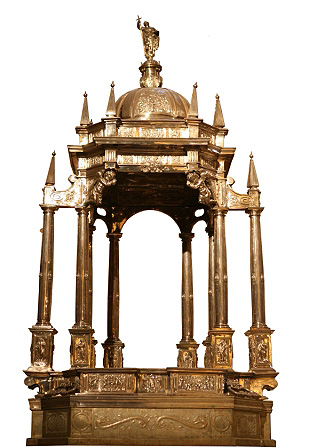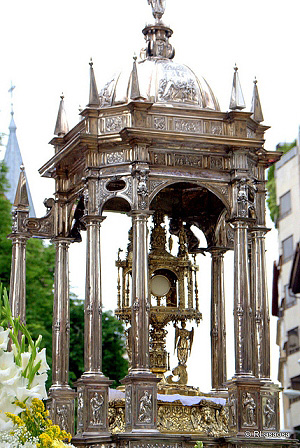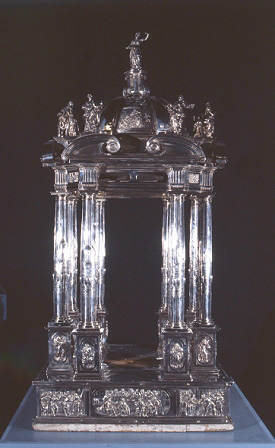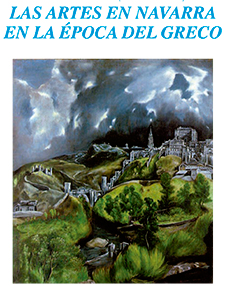AROUND THE 4TH CENTENARY OF EL GRECO (1541-1614). THE ARTS IN NAVARRA IN THE AGE OF EL GRECO
September 5, 2013
The silversmith Velázquez de Medrano and microarchitecture in silver
D. Ignacio Miguéliz Valcarlos. UNED Pamplona
Although a priori it may seem that there is no relationship between architecture and silverware, a simple analysis of silver works allows us to see how architectural motifs appear as decorative themes. Indeed, in many silver pieces we will be able to see how the decoration is articulated by means of elements taken from architecture, especially throughout the 15th and 16th centuries, when we will see how it is arranged in knots and macollas of chalices, ciboria, monstrances and crosses, in the temples of monstrances and in the bodies of chalices or sacrals. This fact is of great importance, since it should not be forgotten that an architectural work cannot be transferred from one place to another, but the silver pieces that are copying the most innovative architectural solutions in thriving centers, will import these models to other more remote and secondary populations that in this way will get to know the new languages that are being imposed in architecture.
Navarre has important examples of architectural works in silverware, such as the reliquaries of the Holy Sepulchre, Lignum Crucis and Santa Espina and the monstrance of the cathedral of Pamplona, the reliquary arm of San Saturnino in the church of the same name in Pamplona, or the monstrances of Aibar and Sangüesa. The latter is precisely the only existing example in Navarre of a turriform monstrance, probably the greatest contribution of Hispanic silverware to universal silverware, since the monstrance of the cathedral of Pamplona lacks a piece of this type subject, true silver architecture, the cathedral's example responding to the typology of hands.
To compensate for this lack, Bishop Antonio Zapata y Cisneros (1550-1635) commissioned the silversmith José Velázquez de Medrano (1561-1622), one of the best Navarrese craftsmen of the time, to build a processional platform for the cathedral monstrance. It is a work in the form of an architectural temple covered by a dome, very influenced by Juan de Arfe and El Escorial, and with a rich iconographic ornamentation related to the Eucharist, which was inaugurated in the Corpus Christi of 1598. When he received this commission, Velázquez was working on a work of similar characteristics for the cathedral of Tarazona (1594-1597). Also at this time he was commissioned to execute a processional monstrance for the cathedral of Huesca (1596-1601), of turriform form composed of three bodies, perhaps the most architectural piece made by this master, as it presented pure lines with very little decoration. Finally, and probably related to the previous work, he was commissioned to execute the monstrance for the church of San Pablo in Zaragoza (1604-1606), also turriform, but with a greater decorative load and influenced by the monstrance of the Cathedral, the work of Pedro Lamaison.

Velázquez de Medrano, templete for the Eucharistic monstrance of the cathedral of Pamplona

Velázquez de Medrano, templete for the Eucharistic monstrance of the cathedral of Pamplona
But Velázquez de Medrano's production was not limited to the execution of these great architectural works, as he also made the macolla of the cross of Cirauqui, begun by his father-in-law, Felipe de Guevara, and which constitutes his first work of an architectural nature, the chalices of Artajona and Eguaras, the crucifixes of Arróniz and Cirauqui, or the ciborium of Ardaiz. Thus, it can be said that his influence in the Pamplona center expanded throughout the 17th century, and that, as we can see, his fame and prestige was not limited only to the Pamplona workshop, but expanded beyond the borders of Navarre, receiving first-rate commissions from neighboring territories such as Tarazona, Huesca or Zaragoza.

Velázquez de Medrano, templete for the eucharistic monstrance of the cathedral of Tarazona
PROGRAM
Tuesday, 3rd September
El Greco on his 4th Centenary
Ana Carmen Lavín Berdonces. Director of the El Greco Museum
El Greco and Toledo
Ms. Ana Carmen Lavín Berdonces. Director of the El Greco Museum
Wednesday, 4th September
Of patrons and artists
D. Ricardo Fernández Gracia. Chair of Heritage and Art of Navarre
Juan de Anchieta: a genius of sculpture
Ms. María Concepción García Gainza. Chair of Navarrese Heritage and Art
Thursday, 5th September
Rolan Mois and the beginnings of Counter-Reformation painting in Navarre
Mr. Jesús Criado Mainar. University of Zaragoza
The silversmith Velázquez de Medrano and micro-architecture in silver
D. Ignacio Miguéliz Valcarlos. UNED Pamplona

